This viewpoint is part of Chapter 4 of USMCA Forward 2025, which focuses on areas where deepening cooperation between the United States, Mexico, and Canada can help advance key economic and national security goals.
The USMCA was created, negotiated, approved, and enacted during President Trump’s first term. That would be a remarkable feat for any free trade agreement (FTA), but considering that the USMCA is the most comprehensive, high-standard, and innovative trade agreement in the world, it’s an astonishing achievement.
And the timing could not have been better. Modernizing North American trade at the outset of the COVID19 pandemic positioned the region for a rapid rebound with the U.S. as the engine of growth. This was most evident for the auto industry, which is the backbone of manufacturing across the region and a key contributor to growth, employment, and innovation. In 2023, the auto sector added more than $800 billion to the U.S. economy, about 11% of total manufacturing output, supporting nearly 10 million American jobs. Remarkably, every job with an auto manufacturer in the United States creates nearly 12 other jobs upstream (such as suppliers) and downstream (like dealerships).
Auto supply chains throughout the U.S., Mexico, and Canada are so tightly knit that we don’t merely sell vehicles to each other, we build them together, making North America the world’s second largest auto-producing region. Working with its neighbors has also positioned the United States as the world’s second largest auto-manufacturing country. Toyota is proud to contribute to that title through our 10 U.S. plants, which support 190,000 jobs across America directly and with our dealer partners.
Under the USMCA, America’s role as an auto-manufacturing powerhouse has been bolstered. The agreement has also been a success for U.S. workers, consumers, farmers, and firms, but in the spirit of kaizen, or continuous improvement, it could be enhanced, and its innovative mechanism to modernize allows all three parties to do just that.
The USMCA is a paradigm-shifting agreement that views FTAs as dynamic deals that can be updated to address new challenges and seize new opportunities. As the three parties convene for the 2026 review, it will be important to focus on strengthening the regional supply of critical minerals to meet forecasted demand for artificial intelligence, defense, energy, manufacturing, and technology. A comprehensive approach is essential to mitigate supply chain risks for materials that are highly vulnerable to disruptions, price shocks, and shortages. Firms and innovators across the economy have a vested interest in shoring up this supply chain. That’s certainly the case for Toyota’s new battery plant in Liberty, North Carolina. Announced on the heels of the USMCA’s enactment, this $14 billion plant will employ over 5,000 people to build batteries for hybrid, plug-in-hybrid, and electric vehicles. It is the largest investment in a single place that Toyota has made anywhere in the world.
A strategic critical mineral plan will help expand and secure regional supply chains, and the USMCA is the vehicle to drive it forward. Three steps towards this goal include:
Specifying strategic minerals. Establish a targeted list of strategic minerals that would be integral to qualification under the USMCA. Importantly, the list should differentiate high-value rare earths from bulk commodities in determining qualification rules and transition periods for complying with them. A cumulation rule would help accelerate the pace of mining, processing, and refining by counting operations across all three countries toward compliance. The “yarn forward” rule for textiles in the USMCA offers an example of how this could be adapted for critical minerals.
Securing access. Deploy financial tools to mitigate risks critical mineral projects face due to massive up-front costs and market volatility. Low-interest loans, tax credits, and public-private partnerships that target gaps in early-stage development, midstream processing, and co-product recovery can catalyze private capital and accelerate innovation. Aligning trade rules and remedies across all three markets will help protect these investments and secure access. From foreign investment screening for mining, processing, refining, and manufacturing operations to the application of anti-dumping and countervailing duty remedies, USMCA parties should develop and enforce regionwide rules.
Stabilizing prices. Set price bands for the specified minerals to protect infrastructure investments and long-term purchase agreements from price shocks due to dumping of those minerals on the global market. If a price for a commodity falls below the floor set in the price band, it would trigger collective action by USMCA parties, such as tariffs, stockpile releases, or tax credits. This would protect profitability for producers and purchasers that have complied with the agreement.
Since President Trump began negotiating the USMCA, Toyota has been committed to its success. While the agreement’s novel mechanisms to evolve enable it to meet emerging 21st century conditions, the stability and predictability of the framework is foundational to attracting capital for multibillion dollar, multidecade investments. The transformational potential of the USMCA is just being realized as the three parties begin the review process. This is a prime opportunity to build upon the agreement’s success to unleash North America’s energy future and boost its manufacturing by securing the supply of critical minerals.
-
Acknowledgements and disclosures
Toyota is a donor to the Brookings Institution. The conclusions and recommendations of any Brookings publication are solely those of its author(s), and do not reflect the views of the Institution, its management, or its scholars.
The Brookings Institution is committed to quality, independence, and impact.
We are supported by a diverse array of funders. In line with our values and policies, each Brookings publication represents the sole views of its author(s).





Commentary
From mineral mines to assembly lines: How the USMCA can drive a regional critical mineral supply chain
March 5, 2025